这一篇续上篇, 让我们继续来学习一下,Freemarker,话不多说,煌sir带你上干货~~
一. 其他指令
1.运算符
- 算数运算符:FreeMarker表达式中完全支持算术运算
| 算数运算符 |
| + |
| - |
| * |
| / |
| % |
- 逻辑运算符
| 逻辑运算符 |
描述 |
| && |
逻辑与 |
| || |
逻辑或 |
| ! |
逻辑非 |
- 比较运算符
| 比较运算符 |
描述 |
| == |
判断两个值是否相等 |
| != |
判断两个值是否不等 |
| >或者gt |
判断左边值是否大于右边值 |
| >=或者gte |
判断左边值是否大于等于右边值 |
| <或者lt |
判断左边值是否小于右边值 |
| <=或者lte |
判断左边值是否小于等于右边值 |
- 注意:>、>=、<、<= 可能出现与预期结果不一致的情况,建议使用等效的字母
实例
<#if num > 60 >
num大于60
</#if>
- 如果num为100,num表示条件成立,输出结果:
- 60 > num 大于 60
- 建议编写方式
<#if num gt 60 >
num大于60
</#if>
2. 空值处理
- 判断某变量是否存在使用 “??”
变量?? ,如果不为空返回true,如果为空返回false
Controller:
@GetMapping("/if") public String _if(Model model) { //设置数据 model.addAttribute("token", 1234); model.addAttribute("token2", "5678"); return "if"; }
if.ftl:
<#--空值处理--> <#--不为空处理--> <#if token??> token不为空 <br/> </#if> <#--为空处理--> <#if !token3??> token3为空 <br/> </#if> <#--默认值--> ${token3!'3的默认值'}<br/>
测试:
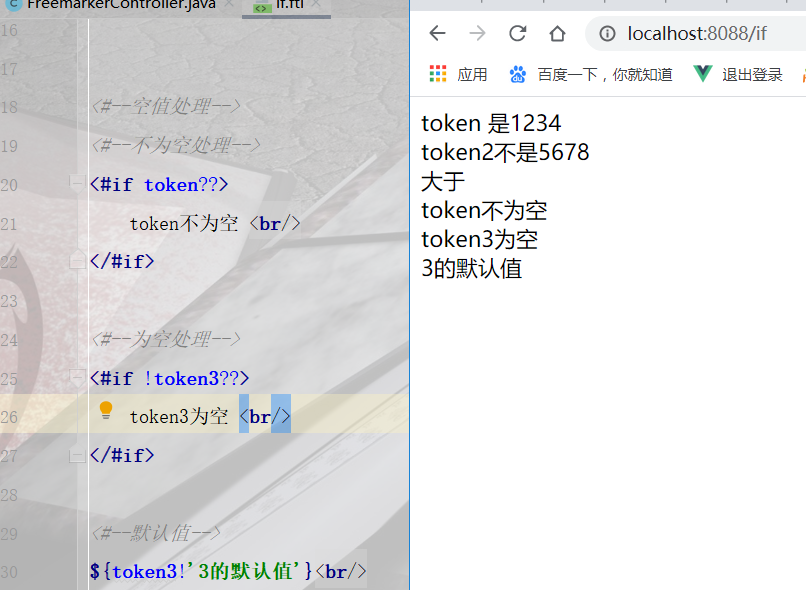
3.内建函数
内建函数语法格式: 变量+?+函数名称
//和到某个集合的大小
${集合名?size}
//显示年月日:
${日期?date}
//显示时分秒:
${日期?time}
//显示日期+时间:
${日期?datetime} <br>
//自定义格式化:
${日期?string("yyyy年MM月")}
//不想显示为每三位分隔的数字
${数字变量?c}
//将json字符串转成对象
text?eval
Controller:
@GetMapping("/method") public String method(Model model) { //集合 ArrayList<String> list = new ArrayList<>(); list.add("abc"); list.add("1234"); model.addAttribute("list", list); //时间 model.addAttribute("birthday", new Date()); // 整形 model.addAttribute("num", 12345678); //JSON数据 model.addAttribute("userJSON", JSONObject.toJSONString(new User("aaa", "bbb", 33))); //设置页面 return "method"; }
method.ftl:
显示集合大小: ${list?size} <br/>
显示年月日:${birthday?date} <br/>
显示时分秒: ${birthday?time} <br/>
显示日期+时间: ${birthday?datetime} <br/>
自定义格式化: ${birthday?string("yyyy年MM月")}<br/>
${birthday?string("yyyy/MM/dd HH:mm:ss:SSS")}<br/>
整形数据:<br/>
默认显示:${num} <br/>
格式化:${num?c} <br/>
JSON数据:<br/>
字符串:${userJSON} <br/>
<#assign user=userJSON?eval />
对象输出:${user.username} <br/>
测试:
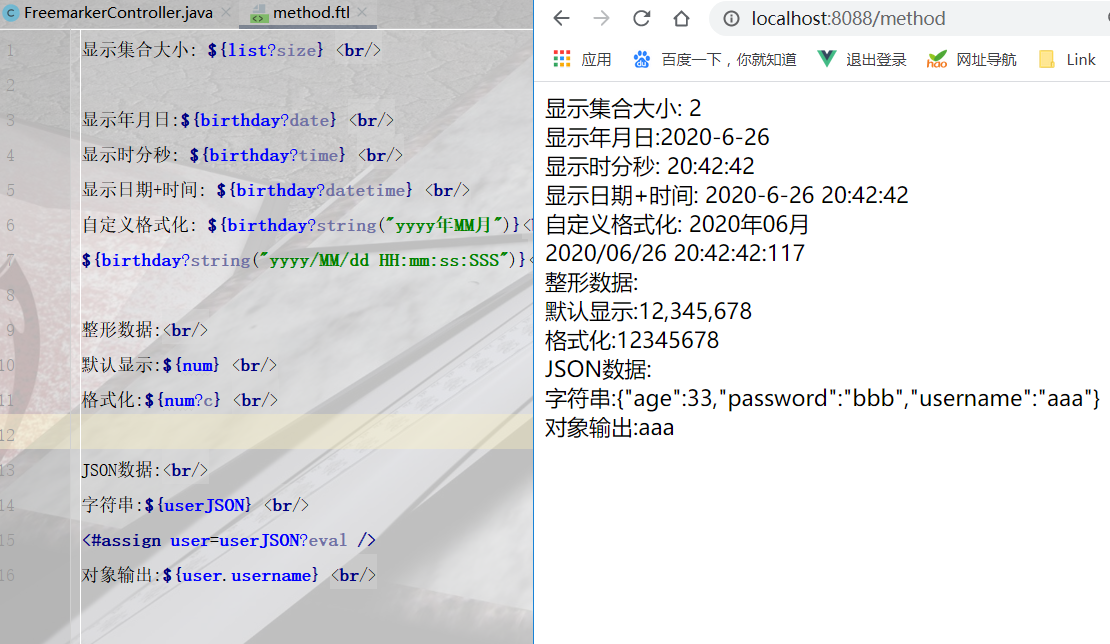
二.静态化
1.模板文件静态化
定义模板文件,使用freemarker静态化程序生成html文件
-
步骤1:修改pom文件,添加IO依赖
- 我上篇最开始的依赖已提供(可无需再添加)
<dependency> <groupId>org.apache.commons</groupId> <artifactId>commons-io</artifactId> </dependency>
步骤二:创建 src/test/resources文件夹 ,并设置其为资源文件夹

设置方式一:
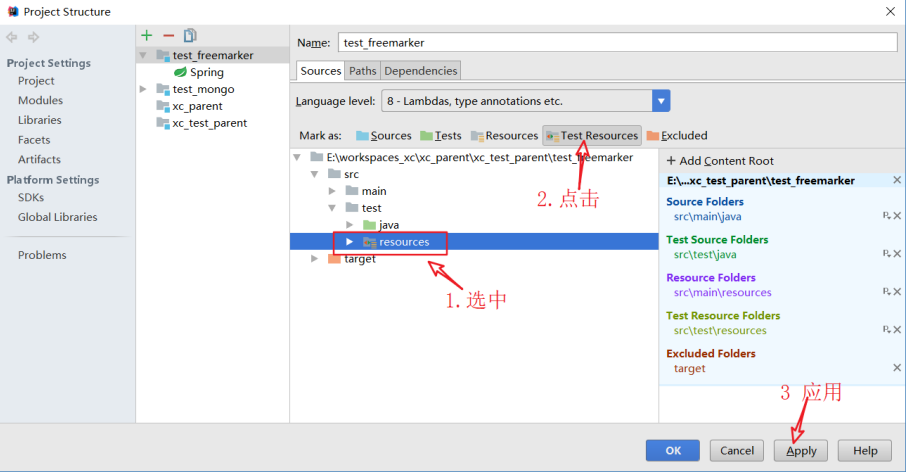
设置方式二:
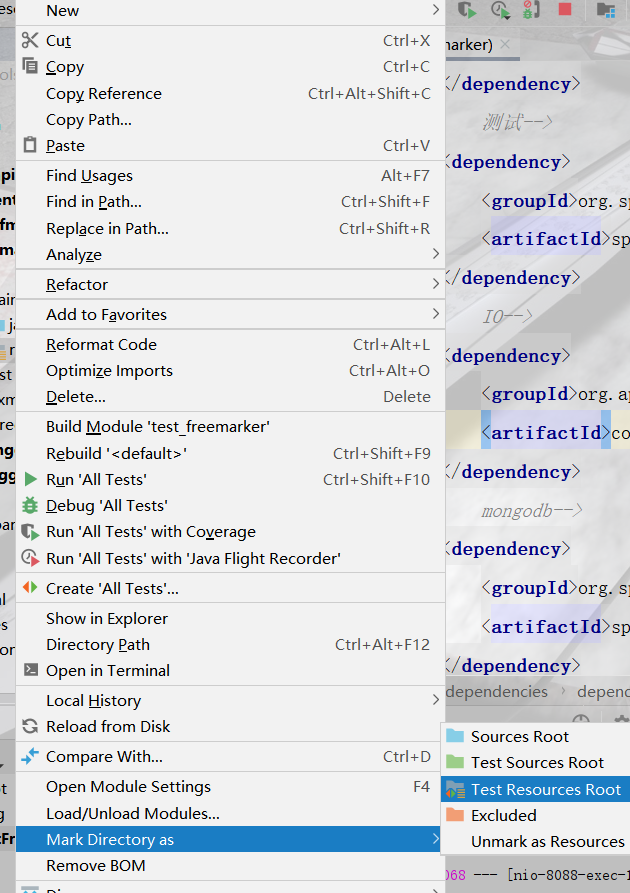
步骤三:创建测试模板文件
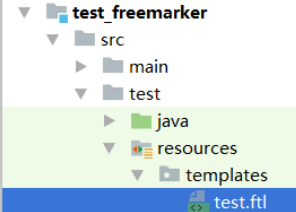
<!DOCTYPE html> <html lang="en"> <head> <meta charset="UTF-8"> <title>Title</title> </head> <body> ${name} </body> </html>
步骤四:编写测试类
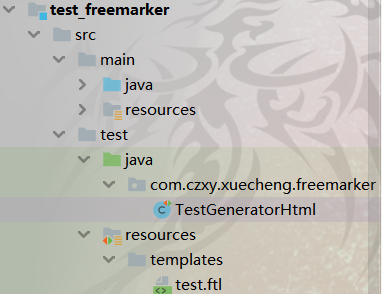
@Test
public void tset1() throws Exception {
//根据模板生成html
// 1.核心配置类
Configuration configuration = new Configuration(Configuration.getVersion());
// 2.设置模板文件夹
// 2.1.获得类路径 /test_freemarker/target/test-classes/
String classpath = this.getClass().getResource("/").getPath();
System.out.println(classpath);
// 2.2.静态目录
// File templateDir = new File(classpath); //在resource根目录下创,不用额外路径
File templateDir = new File(classpath,"/templates/");
// 2.3.给配置类设置操作目录
configuration.setDirectoryForTemplateLoading(templateDir);
// 3.设置编码
configuration.setDefaultEncoding("UTF-8");
// 4.获得具体模板 test.ftl
Template template = configuration.getTemplate("test.ftl");
//5.准备数据
HashMap<String, String> map = new HashMap<>();
map.put("name","ce999");
// 6.静态haul生产,字符串内容
String s = FreeMarkerTemplateUtils.processTemplateIntoString(template, map);
System.out.println(s);
// 7.将 "字符串"写入文件汇总
File file = new File(templateDir,"test.html");
FileUtils.writeStringToFile(file,s);
}
步骤五:测试结果
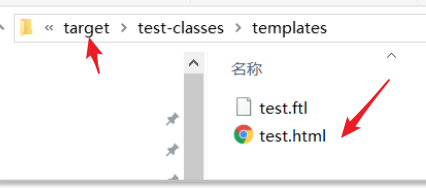
2.模板字符串静态化
定义模板字符串,使用freemarker静态化程序生成html文件
@Test
public void testString() throws Exception {
// 1.定义字符串模板-后期数据从数据库查询
String stringTemplate="<!DOCTYPE html>\n" +
"<html lang=\"en\">\n" +
"<head>\n" +
" <meta charset=\"UTF-8\">\n" +
" <title>Title</title>\n" +
"</head>\n" +
"<body>\n" +
"${name}\n" +
"</body>\n" +
"</html>";
// 2.声明模板加载器
StringTemplateLoader templateLoader = new StringTemplateLoader();
templateLoader.putTemplate("myTemplate",stringTemplate);
// 3.核心配置类,需要使用模板加载器,最终将字符串加载成模板
Configuration configuration = new Configuration(Configuration.getVersion());
configuration.setTemplateLoader(templateLoader);
// 4.获得指定命名模板
Template myTemplate = configuration.getTemplate("myTemplate", "UTF-8");
// 5.准备数据
HashMap<String, String> map = new HashMap<>();
map.put("name","字符串填充666");
// 6.静态化
String str = FreeMarkerTemplateUtils.processTemplateIntoString(myTemplate, map);
// 7.IO 写入
String path = this.getClass().getResource("/templates").getPath();
File file = new File(path, "test1.html");
FileUtils.writeStringToFile(file,str);
}
同理:测试结果

看完恭喜你,又知道了一点点!!!
你知道的越多,不知道的越多!
~感谢志同道合的你阅读, 你的支持是我学习的最大动力 ! 加油 ,陌生人一起努力,共勉!!
来源:oschina
链接:https://my.oschina.net/ithuang/blog/4325867